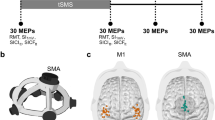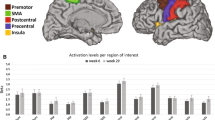Abstract
Recently, it was shown that patients have different functional activation patterns within affected primary sensorimotor cortex (SMC) after intensive rehabilitation therapy. This individual difference was supposed to depend on the integrity of the cortico-spinal fibres from the primary motor cortex. In this study, we considered whether patients with different fMRI activation patterns after intensive rehabilitation therapy suffered from different cortico-spinal fibre lesions. To comprehend this circumstance a lesion subtraction analysis was used. To verify these results with the use of transcranial magnetic stimulation motor evoked potentials was also derived. Patients were treated after a modified version of constraint-induced movement therapy (modCIMT; 3 h daily for 4 weeks). Increased and decreased SMC activation showed similar individual patterns as described previously. These activation differences depend on the integrity of the cortico-spinal tract, which was measured via lesion subtraction analysis between patient groups, and was supported by affected motor evoked potentials.



Similar content being viewed by others
Abbreviations
- BOLD:
-
Blood oxygenation level dependent
- CIMT:
-
Constraint-induced movement therapy
- CMCT:
-
Central motor conduction times
- fMRI:
-
Functional magnetic resonance imaging
- MAL-AoU:
-
Motor activity log with amount of use
- MAL-QoM:
-
Motor activity log with quality of movement
- MEP:
-
Motor evoked potentials
- modCIMT:
-
Modified version of constraint-induced movement therapy
- SMC:
-
Primary sensorimotor cortex
- TMS:
-
Transcranial magnetic stimulation
- WMFT-FA:
-
Wolf motor function test with functional ability
- WMFT-sec:
-
Wolf motor function test with number of seconds
References
Cohen J (1988) Statistical power analysis for the behavioral science. Lawerance Erlbaum Associates, Hillsdale
Dettmers C, Teske U, Hamzei F, Uswatte G, Taub E, Weiller C (2005) Distributed form of constraint-induced movement therapy improves functional outcome and quality of life after stroke. Arch Phys Med Rehabil 86:204–209
Escudero JV, Sancho J, Bautista D, Escudero M, Lopez-Trigo J (1998) Prognostic value of motor evoked potential obtained by transcranial magnetic brain stimulation in motor function recovery in patients with acute ischemic stroke. Stroke 29:1854–1859
Evans AC, Kamber M, Collins DL, Macdonald D (1994) An MRI-based probabilistic atlas of neuroanatomy. In: Shorvon S, Fish D, Andermann F, Bydder GM, Stefan H (eds) Magnetic resonance scanning and epilepsy. Plenum, New York, pp 263–274
Fink GR, Frackowiak RS, Pietrzyk U, Passingham RE (1997) Multiple nonprimary motor areas in the human cortex. J Neurophysiol 77:2164–2174
Fries W, Danek A, Scheidtmann K, Hamburger C (1993) Motor recovery following capsular stroke. Role of descending pathways from multiple motor areas. Brain 116:369–382
Friston KJ, Ashburner J, Frith CD, Poline J-B, Heather JD, Frackowiak RS (1995a) Spatial registration and normalization of images. Hum Brain Map 2:1–25
Friston KJ, Holmes AP, Worsley KJ, Poline JB, Frith CD, Frackowiak RS (1995b) Statistical parametric maps in functional imaging: a general linear approach. Hum Brain Map 2:189–210
Friston KJ, Ashburner J, Poline JB, Frith CD, Heather JD, Frackowiak RS (1997) Spatial realignment and normalization of images. Hum Brain Map 2:165–189
Hamzei F, Knab R, Weiller C, Rother J (2003a) The influence of extra- and intracranial artery disease on the BOLD signal in FMRI. Neuroimage 20:1393–1399
Hamzei F, Rijntjes M, Dettmers C, Glauche V, Weiller C, Büchel C (2003b) The human action recognition system and its relationship to Broca’s area: an fMRI study. Neuroimage 19:637–644
Hamzei F, Liepert J, Dettmers C, Weiller C, Rijntjes M (2006) Two different reorganization patterns after rehabilitative therapy: an exploratory study with fMRI and TMS. Neuroimage 31:710–720
Johansen-Berg H, Dawes H, Guy C, Smith SM, Wade DT, Matthews PM (2002) Correlation between motor improvements and altered fMRI activity after rehabilitative therapy. Brain 125:2731–2742
Karnath HO, Fruhmann Berger M, Kuker W, Rorden C (2004) The anatomy of spatial neglect based on voxelwise statistical analysis: a study of 140 patients. Cereb Cortex 14:1164–1172
Lee CC, Jack CR Jr, Riederer SJ (1998) Mapping of the central sulcus with functional MR: active versus passive activation tasks. AJNR 19:847–852
Liepert J, Storch P, Fritsch A, Weiller C (2000) Motor cortex disinhibition in acute stroke. Clin Neurophysiol 111:671–676
Loubinoux I, Carel C, Alary F, Boulanouar K, Viallard G, Manelfe C, Rascol O, Chollet F (2001) Within-session and between session reproducibility of cerebral sensorimotor activation: a test–retest effect evidenced with functional magnetic resonance imaging. J Cereb Blood Flow Meta 21:592–607
Loubinoux I, Carel C, Pariente J, Dechaumont S, Albucher JF, Marque P, Manelfe C, Chollet F (2003) Correlation between cerebral reorganization and motor recovery after subcortical infarcts. NeuroImage 20:2166–2180
Mark VW, Taub E, Morris DM (2006) Neuroplasticity and constraint-induced movement therapy. Eura Medicophys 42:269–284
Miltner WH, Bauder H, Sommer M, Dettmers C, Taub E (1999) Effects of constraint-induced movement therapy on patients with chronic motor deficits after stroke: a replication. Stroke 30:586–592
Morecraft RJ, Herrick JL, Stilwell-Morecraft KS, Louie JL, Schroeder CM, Ottenbacher JG, Schoolfield MW (2002) Localization of arm representation in the corona radiata and internal capsule in the non-human primate. Brain 125:176–198
Murase N, Duque J, Mazzocchio R, Cohen LG (2004) Influence of interhemispheric interactions on motor function in chronic stroke. Ann Neurol 55:400–409
Nelles G, Jentzen W, Jueptner M, Muller S, Diener HC (2001) Arm training induced brain plasticity in stroke studied with serial positron emission tomography. Neuroimage 13:1146–1154
Newton JM, Ward NS, Parker GJ, Deichmann R, Alexander DC, Friston KJ, Frackowiak RS (2006) Non-invasive mapping of corticofugal fibres from multiple motor areas—relevance to stroke recovery. Brain 129:1844–1858
Niehaus L, Bajbouj M, Meyer BU (2003) Impact of interhemispheric inhibition on excitability of the non-lesioned motor cortex after acute stroke. Suppl Clin Neurophysiol 56:181–186
Pereon Y, Aubertin P, Guiheneuc P (1995) Prognostic significance of electrophysiological investigations in stroke patients: somatosensory and motor evoked potentials and sympathetic skin response. Neurophysiol Clin 25:146–157
Rijntjes M, Hobbeling V, Hamzei F, Dohse S, Ketels G, Liepert J, Weiller C (2005) Individual factors in constraint-induced movement therapy after stroke. Neurorehabil Neural Repair 19:238–249
Rorden C, Brett M (2000) Stereotaxic display of brain lesions. Behav Neurol 12:191–200
Schaechter JD, Kraft E, Hilliard TS, Dijkhuizen RM, Benner T, Finklestein SP, Rosen BR, Cramer SC (2002) Motor recovery and cortical reorganization after constraint-induced movement therapy in stroke patients: a preliminary study. Neurorehabil Neural Repair 16:326–338
Sterr A, Elbert T, Berthold I, Kolbel S, Rockstroh B, Taub E (2002) Longer versus shorter daily constraint-induced movement therapy of chronic hemiparesis: an exploratory study. Arch Phys Med Rehabil 83:1374–1377
Stinear CM, Barber PA, Smale PR, Coxon JP, Fleming MK, Byblow WD (2007) Functional potential in chronic stroke patients depends on corticospinal tract integrity. Brain 130:170–180
Szaflarski JP, Page SJ, Kissela BM, Lee JH, Levine P, Strakowski SM (2006) Cortical reorganization following modified constraint-induced movement therapy: a study of 4 patients with chronic stroke. Arch Phys Med Rehabil 87:1052–1058
Taub E, Miller NE, Novack TA, Cook EW III, Fleming WC, Nepomuceno CS, Connell JS, Crgo JE (1993) Technique to improve chronic motor deficits after stroke. Arch Phys Med Rehabil 74:347–354
Taub E, Uswatte G, Mark VW, Morris DM (2006a) The learned nonuse phenomenon: implications for rehabilitation. Eura Medicophys 42:241–256
Taub E, Uswatte G, King DK, Morris D, Crago JE, Chatterjee A (2006b) A placebo-controlled trial of constraint-induced movement therapy for upper extremity after stroke. Stroke 37:1045–1049
Tombari D, Loubinoux I, Parinete J, Gerdelat A, Albucher J-F, Tardy J, Cassol E, Chollet F (2004) A longitudinal fMRI study: in recovering and then in clinically stable sub-cotical stroke patients. NeuroImage 23:827–839
Ward NS, Brown MM, Thompson AJ, Frackowiak RS (2006) Longitudinal changes in cerebral response to proprioceptive input in individual patients after stroke: an FMRI study. Neurorehabil Neural Repair 20:398–405
Weiller C, Jueptner M, Fellows S, Rijntjes M, Leonhardt G, Kiebel S, Muller S, Diener HC, Thilmann AF (1996) Brain representation of active and passive movements. Neuroimage 4:105–110
Wittenberg GF, Chen R, Ishii K, Bushara KO, Eckloff S, Croarkin E, Taub E, Gerber LH, Hallett M, Cohen LG (2003) Constraint-induced therapy in stroke: magnetic-stimulation motor maps and cerebral activation. Neurorehabil Neural Repair 17:48–57
Wohrle JC, Behrens S, Mielke O, Hennerici MG (2004) Early motor evoked potentials in acute stroke: adjunctive measure to MRI for assessment of prognosis in acute stroke within 6 hours. Cerebrovasc Dis 18:130–134
Wolf SL, Lecrew DE, Barton LA, Jann BB (1989) Forced use of hemiplegic upper extremities to reverse the effect of learned nonuse among chronic stroke and head-injured patients. Exp Neurol 104:125–132
Wolf SL, Winstein CJ, Miller JP, Taub E, Uswatte G, Morris D, Giuliani C, Light KE, Nichols-Larsen D (2006) Effect of constraint-induced movement therapy on upper extremity function 3 to 9 months after stroke: the EXCITE randomized clinical trial. JAMA 296:2095–2104
Acknowledgments
We are grateful to P.T. Alleyne-Dettmers, Ph.D. for editing the text. We thank C. Büchel for his comments during preparation of the study’s design and an early version of the manuscript and Thomas Wolbers and Volkmar Glauche for his statistical support. We are grateful to all individuals who participated in this study, particularly to Ulrike Teske how performed the training sessions. CW was supported by DFG, BMBF (GFGO 0 123 7301—01GO 0105; DFG: WE 1352/13-1), EU (QLK6 CT 1999 02140) and by the Competence network stroke (01GI9917).
Author information
Authors and Affiliations
Corresponding author
Rights and permissions
About this article
Cite this article
Hamzei, F., Dettmers, C., Rijntjes, M. et al. The effect of cortico-spinal tract damage on primary sensorimotor cortex activation after rehabilitation therapy. Exp Brain Res 190, 329–336 (2008). https://doi.org/10.1007/s00221-008-1474-x
Received:
Accepted:
Published:
Issue Date:
DOI: https://doi.org/10.1007/s00221-008-1474-x




